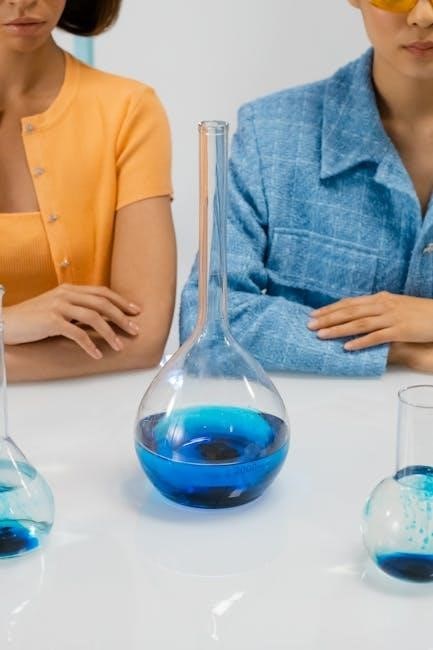The Color Personality Test is a popular tool that uses color preferences to reveal personality traits, emotional tendencies, and behavioral patterns. Based on psychological principles, it helps individuals gain self-awareness and improve communication by associating specific colors with distinct characteristics. Widely used for personal growth, education, and workplace team-building, the test provides insights into how colors influence human behavior and decision-making processes.
1.1 Understanding the Basics of Color Psychology
Color psychology explores how colors influence emotions, behavior, and decision-making; It suggests that specific hues evoke distinct feelings and traits, shaping individual preferences and reactions. In the context of personality tests, colors like red, blue, green, and yellow are linked to traits such as energy, trust, growth, and optimism. This foundational concept underscores the connection between color choices and personality characteristics.
1.2 Overview of the Color Personality Test Concept
The Color Personality Test evaluates individuals by linking their color preferences to specific traits and behaviors. It categorizes personalities into primary and secondary colors, offering insights into strengths, weaknesses, and emotional tendencies. The test is simple, involving color selection and analysis, making it accessible for self-assessment and professional use in team-building, education, and personal development.
History and Development of the Color Personality Test
The Color Personality Test originated from early psychological studies on color perception and behavior. Don Lowry’s True Colors system laid the foundation, evolving into a widely recognized tool for understanding personality traits through color preferences.
2.1 The Role of Don Lowry and True Colors
Don Lowry, inspired by earlier psychologists, developed the True Colors system in the late 1970s. His work introduced a four-color model—orange, gold, blue, and green—each representing distinct personality traits. This system simplified complex psychological concepts, making them accessible for personal and professional development. Lowry’s approach emphasized understanding individual strengths and weaknesses through color associations, fostering effective communication and teamwork.
2.2 Evolution of the Test in Modern Psychology
The Color Personality Test has evolved significantly, integrating modern psychological research and technology. Digital platforms now offer interactive assessments, making the test more accessible. Advances in color psychology have refined trait associations, while social media trends, like the Ktestone test, have popularized its use. This evolution ensures the test remains relevant in understanding personality and behavior.

Structure of the Color Personality Test
The test involves selecting colors from groups, tallying results, and identifying primary colors that reflect personality traits. It’s a simple yet effective tool for self-discovery and analysis.
3.1 How the Test Works: Choosing Colors and Tallying Results
Participants select a color from each group, reflecting their preferences. Results are tallied on a sheet, assigning scores to primary colors like red, blue, green, and yellow. The highest score indicates the dominant personality type, guiding interpretations of traits, strengths, and weaknesses. This method ensures a clear and structured approach to understanding individual personalities effectively.

3.2 The Significance of Primary and Secondary Colors
Primary colors—red, blue, green, and yellow—represent core personality traits, while secondary colors like orange, purple, and pink refine these characteristics. Each color combination reveals unique strengths, weaknesses, and behavioral tendencies. Understanding these hues helps individuals and teams align their actions and communication, fostering harmony and productivity in personal and professional settings.
Color Meanings and Personality Traits
Colors like red, blue, green, and yellow symbolize distinct traits, such as confidence, trust, harmony, and optimism. Secondary colors refine these meanings, offering deeper insights into individual personalities and behaviors.
4.1 Red: Confidence, Energy, and Leadership
Red symbolizes confidence, energy, and leadership, often associated with assertive and action-oriented individuals. People drawn to red are natural leaders, thriving in competitive environments. Their bold nature and strong will make them decisive, while their energy inspires others. However, red personalities may struggle with impulsiveness and dominance, requiring balance to harness their traits effectively.
4.2 Blue: Trust, Loyalty, and Emotional Depth
Blue represents trust, loyalty, and emotional depth, reflecting individuals who prioritize harmony and stability. These personalities are often empathetic, with a strong sense of duty and commitment. Their calm demeanor makes them reliable and compassionate, fostering deep connections. However, blue individuals may struggle with emotional vulnerability and over-sensitivity, highlighting the need for balance in their personal and professional lives.
4.3 Green: Growth, Harmony, and Balance
Green symbolizes growth, harmony, and balance, representing individuals who value stability and practicality. These personalities are often analytical, composed, and focused on personal development. Their love for learning and structured environments drives them to achieve goals systematically. Greens are known for their reserved nature, which can sometimes hinder spontaneity, but their commitment to creating order ensures long-term success and fulfillment.
4.4 Yellow: Optimism, Creativity, and Enthusiasm
Yellow represents optimism, creativity, and enthusiasm, often associated with friendly, spontaneous, and imaginative individuals. People with a strong Yellow personality are known for their positive outlook, love for innovation, and ability to inspire others. Their energy is contagious, fostering a lively and uplifting atmosphere. While they may struggle with patience, their forward-thinking approach and adaptability make them excellent problem-solvers and visionaries.

Applications of the Color Personality Test
The Color Personality Test is widely used for personal growth, enhancing self-awareness, and improving team dynamics. It aids in workplace communication, education, and interpersonal relationships, fostering understanding and collaboration.
5.1 Personal Growth and Self-Awareness

The Color Personality Test aids individuals in understanding their strengths, weaknesses, and emotional tendencies. By identifying dominant colors, users gain insights into their personality, enabling self-reflection and personal development. This tool fosters emotional intelligence, helping individuals set goals and improve relationships. Many downloadable PDF guides offer exercises and worksheets to enhance self-awareness through color-based insights.
5.2 Team Building and Communication in the Workplace
The Color Personality Test enhances workplace dynamics by helping teams understand individual preferences and communication styles. By identifying dominant colors, colleagues can better collaborate, resolve conflicts, and assign roles effectively. This tool fosters empathy and improves teamwork, making it a valuable resource for corporate training and leadership development. Many PDF guides provide strategies for applying color insights in professional settings.

Variations of the Color Personality Test
The Color Personality Test has variations like the Ktestone trend and the Hartman Personality Profile, expanding its approach to understanding personality types through color psychology, aiding personal and professional growth.
6.1 The Ktestone Color Personality Test Trend
The Ktestone Color Personality Test is a recent trend that has gone viral on social media platforms like TikTok. It uses a four-color system to determine personality types, helping users understand their strengths, weaknesses, and communication styles. This test is popular for its simplicity and fun approach, encouraging users to share their results online and compare with others for deeper self-awareness.
6.2 The Hartman Personality Profile and Color Code
The Hartman Personality Profile, as outlined in Dr. Taylor Hartman’s book The Color Code, assigns four colors—red, yellow, blue, and white—to represent core personality traits. This system helps individuals identify their strengths, weaknesses, and stress responses, offering practical insights for personal growth and relationship improvement. It is widely used for self-assessment and professional development, providing a clear framework for understanding human behavior and communication styles.

Practical Examples and Case Studies
Sample test questions guide users to select colors reflecting their traits, with interpretations linking choices to personality insights. Real-life applications demonstrate how test results enhance teamwork, leadership, and self-awareness, providing actionable strategies for personal and professional development.
7.1 Sample Test Questions and Interpretations
The test presents groups of colors, asking users to choose their preferences. Each color selection is linked to specific traits, such as red for confidence or blue for trust. Interpretations reveal personality insights, guiding self-reflection and personal growth. For example, selecting red may indicate leadership qualities, while blue suggests emotional depth. Results are tallied to provide a comprehensive personality profile, enhancing self-awareness and interpersonal understanding.
7.2 Real-Life Applications of the Test Results
The test results are widely applied in team-building, education, and personal growth. For instance, educators use color insights to tailor teaching methods, while professionals leverage them to enhance workplace communication. Individuals share results on social media, fostering self-expression and connection. The practical insights help improve relationships, career choices, and self-awareness, making the test a versatile tool for personal and professional development.
Resources for the Color Personality Test
Downloadable PDF guides and online platforms offer comprehensive tools for understanding color personality insights. These resources provide detailed explanations, quizzes, and scoring systems to help users interpret results effectively.
8.1 Downloadable PDF Guides and Worksheets
Downloadable PDF guides and worksheets provide comprehensive tools for exploring the Color Personality Test. These resources include detailed explanations of color meanings, sample questions, and scoring systems. Users can access quizzes, personality charts, and interpretative guides to understand their results better. Many PDFs, like the True Colors system, offer insights into strengths, weaknesses, and communication styles, aiding in personal and professional development.
8.2 Online Platforms and Tools for Taking the Test
Online platforms offer convenient ways to take the Color Personality Test, with interactive quizzes and instant results. Websites like Uptodown and official True Colors portals provide free assessments, enabling users to discover their color profiles. These tools often include detailed explanations and resources to help individuals interpret their results and apply insights to personal and professional life effectively.

The Future of Color Personality Tests
The future of color personality tests lies in integrating advanced technology and social media trends, making assessments more interactive and accessible. Tools like the Ktestone test are gaining popularity, allowing users to share results online and fostering deeper self-awareness through personalized insights and community engagement.
9.1 Emerging Trends in Color Psychology
Emerging trends in color psychology include the integration of digital tools and social media platforms, such as the Ktestone test, which has gone viral on TikTok. These trends emphasize interactive assessments and personalized insights, making color psychology more accessible and engaging. Advances in technology also enable deeper analysis of color preferences, linking them to behavioral patterns and emotional responses with greater precision;
9.2 The Role of Technology in Personality Assessment

Technology has revolutionized personality assessments by offering digital platforms for color tests, such as downloadable PDF guides and online tools. These innovations enable instant results, detailed reports, and data analysis, enhancing accessibility and efficiency. Interactive tests and mobile apps further personalize the experience, making personality insights available to a global audience with just a few clicks, fostering self-awareness and growth.
The Color Personality Test offers a unique, engaging way to explore personality traits, fostering self-awareness and improving interpersonal understanding. Its versatility makes it a valuable tool for personal and professional growth.
10.1 The Importance of Color Personality Tests in Understanding Human Behavior
Color Personality Tests are invaluable tools for understanding human behavior, offering insights into emotional tendencies, decision-making, and interpersonal interactions. By linking colors to specific traits, these tests enhance self-awareness, emotional intelligence, and communication skills. They provide a unique perspective on personality dynamics, making them widely applicable in personal development, education, and workplace settings to foster better understanding and collaboration.
10.2 Final Thoughts on Leveraging Color Psychology for Personal and Professional Growth
Color psychology offers a powerful framework for self-discovery and improvement. By understanding personality traits linked to colors, individuals can enhance emotional intelligence, communication, and decision-making. Professionally, these insights foster better teamwork and conflict resolution. Embracing color personality tests can lead to profound personal and professional growth, helping individuals align their strengths with their goals and aspirations.
